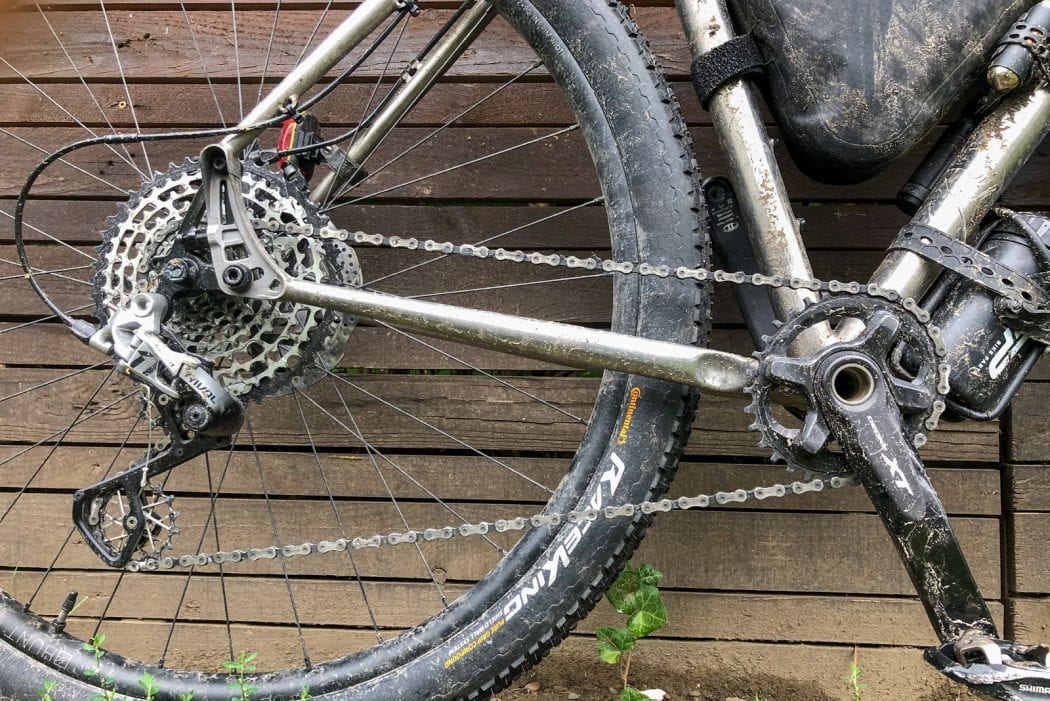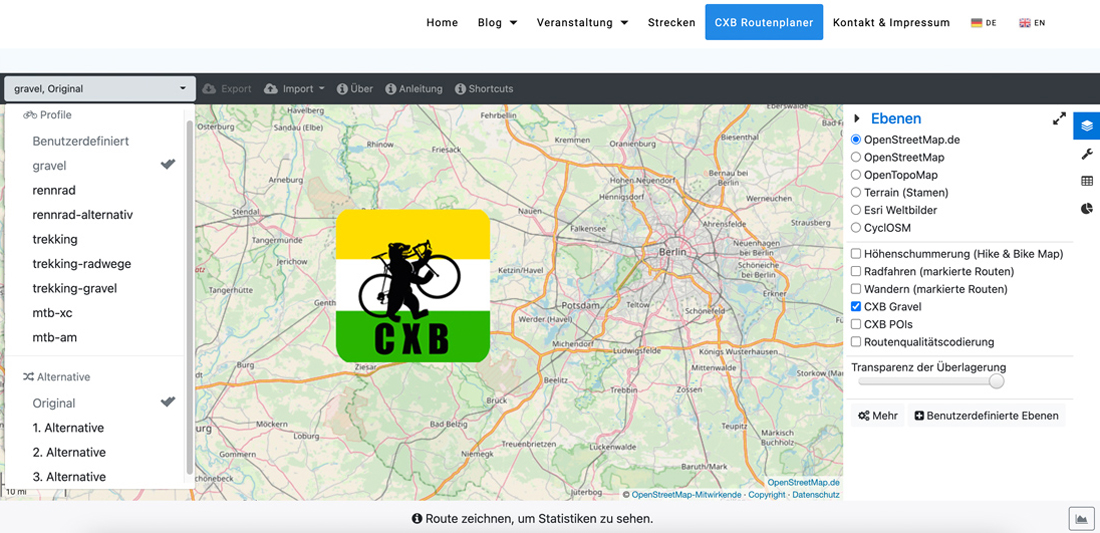Mullet shifting is the term used for gear combinations that combine road shift/brake levers with MTB shift bodies in order to use the gear ratio range of an MTB while still being able to ride a “wide tyre road bike”. These are bikes like my Salsa Fargo or the Bombtrack Beyond or a Storck Grix Pro or an OPEN Wi.De: A bike with the handlebars and gears of a road bike and the gear and tyre width of a mountain bike.
Mullet: In this case, short in the front means a gear ring with 28, 30, 32 or 34 teeth (or less or a little more) and long in the back due to cassettes with 11-50 or 10-50/48. In essence, therefore, 1-speed gears that offer an enormous over- and under-ratio.
Is it necessary to have a Mullet gear system?
No, you certainly don’t need it for normal bike touring or Bikepacking or Graveling. And from my point of view, the “normal” available Gravel and Bikepacking bikes with standard gears are completely sufficient for that.
But in my opinion, there are the following reasons that make a Mullet shifting system interesting:
- When Bikepacking with luggage in mountainous terrain, in order to get up steeper climbs well or to have enough capacity in difficult passages.
- In Bikepacking races or events over several days, when you don’t sleep much and have to cope with many metres of altitude on difficult terrain, then “rescue gears” in a good gear reduction definitely pay off. Especially when the body is tired.
- To maximise the deployment and range of 1-speed gears and to keep all options open and have the right gears ready for almost any terrain.
- If you are not a mountain goat and, with or without luggage, are grateful for every gear on the mountain, but would also like to speed up on the flat.
Now you might object that there are already some Gravel bikes that already meet these requirements and offer enough bandwidth with cassettes of 11-42 or 46. And gears like the Shimano GRX are actually designed for such applications, and shift up to 46 teeth (officially) at the rear with 1×11. However, a 40 or 42 tooth blade then runs at the front, which is why the coveted gear reduction is not particularly large. Sometimes it is not possible to fit smaller blades (34, 32, 30 or even 28) at the front because the frame geo does not allow it, the bottom brackets are designed for road (68 to 70mm) and not for MTB (73mm) and the corresponding MTB cranks cannot be used. (Please correct me if I see this wrong or am overlooking something).

And now you can again say that there are also 2x gear systems, which give you all the possibilities. However, 1x gears have many advantages, because compared to 2x gears they are:
- lighter,
- require less maintenance, as there is no front derailleur and gear lever,
- may even be cheaper than 2-speed,
- leave a tidier appearance on the bike, and have less wear on the chain, which in turn depends on the chainline.
- Or as Tobias says: ” If it’ s not there, it can’t be broken!”.
A counter-argument often cited is a smaller range of gears compared to 2-speed gears, but that is no longer so universally true. My current 1-gear shifting system, for example, has a range of 500%, which is perfectly adequate. In comparison, a normal GRX 1×11 has 418%. And my 2-speed combo on the Bombtrack at 524%.
To make it clear once again: However, there is no right or wrong. In the end, it’s a question of personal riding technique and preferences.
Now it becomes 1x
If you, dear reader, are a 2x fan, then you are welcome to read on, but you don’t have to. Because now it’s about 1-speed Mullet shifting.
With Mullet you are faced with a big challenge: Unfortunately, with 11-speed and 12-speed gears you can no longer combine MTB groupsets with road groupsets from one manufacturer at will. This usually has to do with the respective shift cable lengths. SRAM, for example, offers X-Actuation technology for MTB shifting and Exact Actuation for road shifting. This is not easy to understand for outsiders, but essentially means a different type of rear derailleur actuation and cable length.
BUT: since the introduction of electronic shifting, the issue of group incompatibilities has been eliminated. For example, SRAM Road eTap AXS shift/brake levers can be combined with SRAM MTB AXS rear derailleurs without any problems. That’s great, but it also has its price.
In my case, on the one hand I am a technology fan and would like to build such an eTap AXS shifting system as a Mullet. On the other hand, I would prefer to use a solution that I can repair if the worst comes to the worst.

While I avoided the 1-speed gears on my Bombtrack and built it with a 2-speed, I chose a 1-speed right from the start when building the Salsa Fargo. I also built the bike for the Atlas Mountain Race, so it had to be suitable for the stony trails and many vertical metres. So only Mullet came into question for me and I wanted to ride the 1×11 combination of a 32-tooth crankset at the front and a 11-50 cassette at the rear. This would give me enough speed on the flat, but especially help me climb with a pack in the mountains.
Mullet x 3
In the meantime I have built up and ridden three different 1×11 Mullet variations. And I hereby pass on my assessment and experience:
Variant 1: The Atlas-Proofed brand mix
For the AMR, I went for the combination of SRAM Rival shifters up front and the Shimano XT rear derailleur Shadow Plus RD-M8000 11-speed Long Cage. To combine the road shifters with the Shimano MTB rear derailleur in a functional way, I used the Shiftmate 9, which compensates for the different cable lengths. To do this, the shift cable is rolled once in the Shiftmate and thus diverted before it is inserted into the rear derailleur. The 11-speed Sunrace 11-50 cassette was used. It is relatively cheap, but also has a high wear rate.

Installation: This is relatively easy and no challenge for experienced mechanics. And with a little patience for everyone else as well. Only the correct cable routing in the Shiftmate can be a bit fiddly. I installed the Shiftmate directly in front of the rear derailleur.

Shifting performance: The shifting is adjusted with the adjustment screw on the rear derailleur. However, due to the shiftmate, this is sometimes a little difficult. The shifting itself is easy to adjust. But I miss the possibility to lock the shifting cage for mounting on the Shimano XT, as it is standard on the SRAM rear derailleurs. Nevertheless, this combination proved itself during the winter training weekend in the Spessart and later on the wild ride through the Moroccan Atlas. Unfortunately, a stone hit then put an end to the whole thing and I had to replace it.

Assessment: Good performance, although “more complicated” combinations of brands and model series. With the Shiftmate, of course, an additional part comes into the system, which can also be a potential source of error. But it worked well despite extreme dirt and stress. However, the shift cable in the Shiftmate was slightly worn after about 3,500km.
Cost:
XT rear derailleur – 75 euros
Shiftmate 9 – 34 Euro
Sunrace cassette 11-50 – 73 Euro
Total: 182 euros (without SRAM Rival shifter).
Weight:
XT rear derailleur – 275g
Shiftmate 9 – 17g
Sunrace cassette 11-50 – 512g
Total: 804g
Variant 2: Roadlink Combo
After a stone in Morocco brought my successful Shimano XT Mullet combination to an abrupt end, I took this as an opportunity to try out a new idea. I had a SRAM Rival 1 Type 3.0 11-speed rear derailleur lying around anyway and after I could no longer repair the XT rear derailleur, I decided to add this one.

I know that the SRAM Rival 1 rear derailleur shifts 11-46 without any other help. Tobias rides like this on his Fargo. But the Rival can’t do 11-50 without help. And this help is called Roadlink.

Yes, the Roadlink is actually only intended for Shimano Road rear derailleurs, but I ignored that. The Roadlink adapter from Wolf Tooth is essentially a simple extension of the derailleur hanger and lowers the rear derailleur slightly. This makes it possible to shift larger cassettes with a normal rear derailleur. Of course, you have to consider the rear derailleur capacity, i.e. the “largest possible difference in teeth between the smallest and largest sprocket that a rear derailleur can handle” (Wikipedalia).
Installation: Simply screw the Roadlink onto the derailleur hanger (preferably with a little locktide), then attach the rear derailleur to it. That’s it. After a few kilometres, however, you should retighten the Roadlink screw.

Shifting performance: Shifting was ok, but not as good as with the XT. Of course, this could be due to the fact that the Roadlink was only intended for Shimano road rear derailleurs and the Rival did not work optimally with the Sunrace cassette (11-50) in this sensitive alignment area. However, with the B-Skrew (the screw that adjusts the distance between the rear derailleur and the cassette) and a bit of patience, I was able to achieve a quite useful performance. What I didn’t manage so well was the right chain length. A 116 length was a bit too long. Shortened by 2-3 links too short. In addition, the system changes when the chain is lengthened. But I didn’t spend a lot of time working on this, partly because I just needed a system that worked halfway. And it did that quite well.

Assessment: It was ok, but the shifting could be a bit more precise and crisp. I was able to do my training and touring with it, but I knew that it was only a temporary solution for now. However, I was able to put it under real strain and shift everything without any problems. Basically, I think the Roadlink is pretty good and a great tool for getting more capacity out of road derailleurs. It also works with the Rival, but would probably work even better with an Ultegra, Dura-Ace or 105.
Cost:
Rival rear derailleur – 90 euros
Roadlink – 24 euros
Sunrace cassette 11-50 – 73 euros
Total: 187 euros (without SRAM Rival shifter).
Weight:
Rival rear derailleur – 272g
Roadlink – 17g
Sunrace cassette 11-50 – 512g
Total: 801g
Variant 3: The Ukrainian steel wonder
If you’re into mullet shifting and value design, weight and maximum bandwidth, you can’t ignore the products of Garbaruk. The Ukrainian company has made a name for itself in the production of particularly light and durable steel cassettes and shifting accessories. They also look very stylish. However, they are also expensive, but they have one advantage: with Garbaruk you avoid the Road-MTB combination problems and can do without additional helpers completely. And you achieve a very crisp and precise shifting performance.

All you have to do is install the Garbaruk shifting cages and cogs (available separately and in different colours for Shimano or SRAM shifting bodies) on the rear derailleur and then combine this with a Garbaruk 11-speed cassette that has a width of 10-50 or 10-48. This significantly increases the gear range and offers a gear for speeding with the 10-speed sprocket and a gear for all eventualities in the mountains with the 48 or 50-speed sprocket. However, this may require converting the freehub body from Shimano to XD.

Installation: Some experience is needed here, even though Garbaruk offers pretty good tutorials for this. First you have to remove the cage from the old rear derailleur and install the Garbaruk cage. The Garbaruk cogs with 12/16 teeth (for SRAM) are also used here. The cage is important because it lowers the rear derailleur without lowering it, so that a 48 or 50 sprocket can be driven with enough clearance. Here, however, pay attention to the correct spring tension of the cage during installation.
Then you have to convert the hub freewheel body to XD (which is actually easy to do) and then install the Garbaruk cassette of your choice. I decided to use the 10-48 cassette for now, because I want to see how durable the cassettes really are.

Once everything has been replaced and mounted, you simply insert the rear wheel and adjust the derailleur. It’s easy and hassle-free. For the chain, I chose a length of 118 links with a 30 oval chainring at the front and the 10-48 cassette at the rear, which works very well.
Shifting performance: I’ll be brief: a dream. But you have to take some time to adjust it and make sure that the chain wraps optimally around the cogs (and thus does not slip when starting) and that the derailleur body is close to the cassette. Once adjusted, the Rival/Garbaruk shifts quickly, precisely and smoothly – even under load. The 10 teeth develop their full performance and the 48 teeth have saved me from tricky or steep situations time and again on the Orbit360.

Now I am curious how long the cassette and chain will last. I will change the chain after 2,000 km. And then ride with two chains alternating after every 2,000km. My goal: to ride the cassette for about 8,000km. The price of 200 euros for the cassette seems high at first glance, but comparable cassettes from SRAM also cost as much, if not more (for 12-speed) and have a very good service life. And for the money you get a very light cassette made of steel and milled from one piece (the largest blade is aluminium).

Assessment: My favourite when it comes to mechanical Mullet shifters. I am very taken with the precise shifting, the fairly simple installation (with a little practice) and the Garbaruk concept. Now it remains to be seen how the durability is and whether this overall package justifies the rather high purchase price. So far, a resounding yes.
Cost:
Rival rear derailleur – 90 euros
Garbaruk shift cage – 55 euros
Garbaruk cage rollers – 58 euros
Garbaruk cassette 10-48 – 200 Euro
XD freewheel body – 35 Euro
Total: 438 Euro (without Rival shifter).
Weight:
Rival shifter with Garbaruk shift cage (42g) & Garbaruk shift cage rollers (20g) – 265g.
Garbaruk cassette 10-48 – 295g
Total: 560g
Note: It is also possible to run a rear derailleur with a Garbaruk cage and sprockets with a normal MTB cassette, such as a Sunrace or Shimano XT or SLX. So it doesn’t have to be an expensive Garbaruk cassette. However, Garbaruk points out that the shifting performance may not be completely optimal.
Other mullet possibilities
If you would like to take a closer look at this topic, here are two interesting videos by Path less Pedaled, who have tried out some possible mullet combinations:
In addition, the colleagues from Bikepacking.com have also made an overview on the topic, which shows in a practical way what is possible today:
You will also find a reasonably up-to-date overview of the wide-range cassettes available on the market for Bikepacking:






